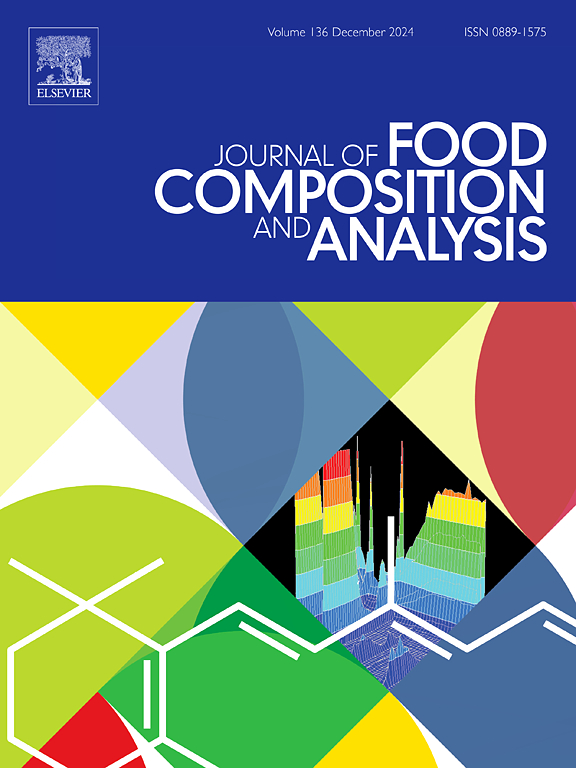基于双金属Au/Os纳米簇的荧光传感器:实现食品中苋菜的快速和现场检测
IF 4.6
2区 农林科学
Q2 CHEMISTRY, APPLIED
引用次数: 0
摘要
食用色素在食品工业中无处不在。然而,它们的过度使用会降低食品质量,也会给消费者带来重大的健康风险。因此,开发快速、现场检测食品中着色剂的有效分析方法至关重要。在这里,我们提出了一种基于独特的聚乙烯亚胺覆盖Au/Os双金属纳米簇(PEI-capped Au/Os NCs)的创新荧光传感器,用于快速和现场检测苋菜,一种普遍的合成红色食用色素。在465 nm处(Φf = 51.5 %)有较强的荧光发射,与苋红相互作用后荧光猝灭。该传感器具有良好的特异性和灵敏度,线性检测范围为0.03 ~ 20.00 μM,检出限低至18.00 nM。值得注意的是,pei封装的Au/Os NCs传感器集成在纸条上,允许使用内置摄像头的智能手机进行视觉捕获和记录荧光变化。该方法已成功地用于葡萄汁、饮料和糖果中苋菜红的快速现场检测。这项工作开创了荧光双金属纳米管在食品色素快速和现场检测中的应用,为食品安全监测提供了一种方便而有力的工具。本文章由计算机程序翻译,如有差异,请以英文原文为准。
Fluorescent sensor based on bimetallic Au/Os nanoclusters: Enabling rapid and on-site detection of amaranth in food
Food colorants are ubiquitous in the food industry. However, their excessive use can degrade food quality and also pose significant health risks to consumers. Accordingly, it is crucial to develop efficient analytical methods for the rapid and on-site detection of colorants in food. Here, we presented an innovative fluorescent sensor based on a unique polyethyleneimine-capped Au/Os bimetallic nanoclusters (PEI-capped Au/Os NCs) for the rapid and on-site detection of amaranth, a prevalent synthetic red food colorant. The synthesized PEI-capped Au/Os NCs exhibit robust fluorescence emission at 465 nm (Φf = 51.5 %), which is significantly quenched upon interaction with amaranth. The sensor demonstrates exceptional specificity and sensitivity, with a linear detection range of 0.03–20.00 μM and a detection limit as low as 18.00 nM. Notably, the PEI-capped Au/Os NCs sensor was integrated onto paper strips, allowing for visual capture and recording of fluorescence changes using a smartphone with a built-in camera. This approach was successfully applied for rapid and on-site detection of amaranth in grape juice beverages and candies. This work pioneers the use of fluorescent bimetallic NCs in the rapid and on-site detection of food colorants, providing a convenient and powerful tool for the surveillance of food safety.
求助全文
通过发布文献求助,成功后即可免费获取论文全文。
去求助
来源期刊

Journal of Food Composition and Analysis
工程技术-食品科技
CiteScore
6.20
自引率
11.60%
发文量
601
审稿时长
53 days
期刊介绍:
The Journal of Food Composition and Analysis publishes manuscripts on scientific aspects of data on the chemical composition of human foods, with particular emphasis on actual data on composition of foods; analytical methods; studies on the manipulation, storage, distribution and use of food composition data; and studies on the statistics, use and distribution of such data and data systems. The Journal''s basis is nutrient composition, with increasing emphasis on bioactive non-nutrient and anti-nutrient components. Papers must provide sufficient description of the food samples, analytical methods, quality control procedures and statistical treatments of the data to permit the end users of the food composition data to evaluate the appropriateness of such data in their projects.
The Journal does not publish papers on: microbiological compounds; sensory quality; aromatics/volatiles in food and wine; essential oils; organoleptic characteristics of food; physical properties; or clinical papers and pharmacology-related papers.
 求助内容:
求助内容: 应助结果提醒方式:
应助结果提醒方式:


